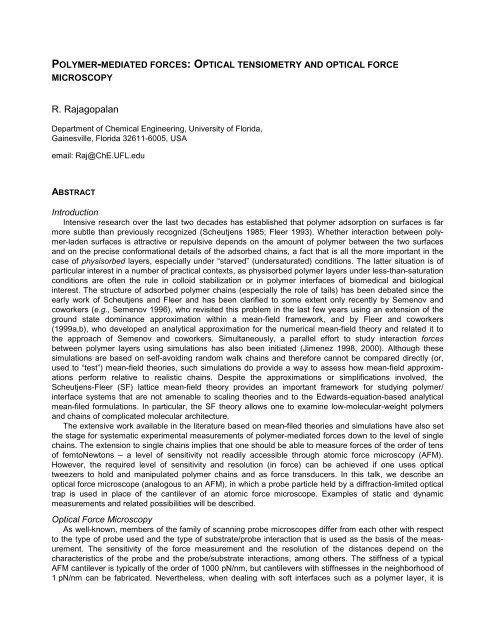Collapse of polymer brushes grafted onto planar ... - Wageningen UR
Collapse of polymer brushes grafted onto planar ... - Wageningen UR
Collapse of polymer brushes grafted onto planar ... - Wageningen UR
You also want an ePaper? Increase the reach of your titles
YUMPU automatically turns print PDFs into web optimized ePapers that Google loves.
POLYMER-MEDIATED FORCES: OPTICAL TENSIOMETRY AND OPTICAL FORCE<br />
MICROSCOPY<br />
R. Rajagopalan<br />
Department <strong>of</strong> Chemical Engineering, University <strong>of</strong> Florida,<br />
Gainesville, Florida 32611-6005, USA<br />
email: Raj@ChE.UFL.edu<br />
ABSTRACT<br />
Introduction<br />
Intensive research over the last two decades has established that <strong>polymer</strong> adsorption on surfaces is far<br />
more subtle than previously recognized (Scheutjens 1985; Fleer 1993). Whether interaction between <strong>polymer</strong>-laden<br />
surfaces is attractive or repulsive depends on the amount <strong>of</strong> <strong>polymer</strong> between the two surfaces<br />
and on the precise conformational details <strong>of</strong> the adsorbed chains, a fact that is all the more important in the<br />
case <strong>of</strong> physisorbed layers, especially under “starved” (undersaturated) conditions. The latter situation is <strong>of</strong><br />
particular interest in a number <strong>of</strong> practical contexts, as physisorbed <strong>polymer</strong> layers under less-than-saturation<br />
conditions are <strong>of</strong>ten the rule in colloid stabilization or in <strong>polymer</strong> interfaces <strong>of</strong> biomedical and biological<br />
interest. The structure <strong>of</strong> adsorbed <strong>polymer</strong> chains (especially the role <strong>of</strong> tails) has been debated since the<br />
early work <strong>of</strong> Scheutjens and Fleer and has been clarified to some extent only recently by Semenov and<br />
coworkers (e.g., Semenov 1996), who revisited this problem in the last few years using an extension <strong>of</strong> the<br />
ground state dominance approximation within a mean-field framework, and by Fleer and coworkers<br />
(1999a,b), who developed an analytical approximation for the numerical mean-field theory and related it to<br />
the approach <strong>of</strong> Semenov and coworkers. Simultaneously, a parallel effort to study interaction forces<br />
between <strong>polymer</strong> layers using simulations has also been initiated (Jimenez 1998, 2000). Although these<br />
simulations are based on self-avoiding random walk chains and therefore cannot be compared directly (or,<br />
used to “test”) mean-field theories, such simulations do provide a way to assess how mean-field approximations<br />
perform relative to realistic chains. Despite the approximations or simplifications involved, the<br />
Scheutjens-Fleer (SF) lattice mean-field theory provides an important framework for studying <strong>polymer</strong>/<br />
interface systems that are not amenable to scaling theories and to the Edwards-equation-based analytical<br />
mean-filed formulations. In particular, the SF theory allows one to examine low-molecular-weight <strong>polymer</strong>s<br />
and chains <strong>of</strong> complicated molecular architecture.<br />
The extensive work available in the literature based on mean-filed theories and simulations have also set<br />
the stage for systematic experimental measurements <strong>of</strong> <strong>polymer</strong>-mediated forces down to the level <strong>of</strong> single<br />
chains. The extension to single chains implies that one should be able to measure forces <strong>of</strong> the order <strong>of</strong> tens<br />
<strong>of</strong> femtoNewtons – a level <strong>of</strong> sensitivity not readily accessible through atomic force microscopy (AFM).<br />
However, the required level <strong>of</strong> sensitivity and resolution (in force) can be achieved if one uses optical<br />
tweezers to hold and manipulated <strong>polymer</strong> chains and as force transducers. In this talk, we describe an<br />
optical force microscope (analogous to an AFM), in which a probe particle held by a diffraction-limited optical<br />
trap is used in place <strong>of</strong> the cantilever <strong>of</strong> an atomic force microscope. Examples <strong>of</strong> static and dynamic<br />
measurements and related possibilities will be described.<br />
Optical Force Microscopy<br />
As well-known, members <strong>of</strong> the family <strong>of</strong> scanning probe microscopes differ from each other with respect<br />
to the type <strong>of</strong> probe used and the type <strong>of</strong> substrate/probe interaction that is used as the basis <strong>of</strong> the measurement.<br />
The sensitivity <strong>of</strong> the force measurement and the resolution <strong>of</strong> the distances depend on the<br />
characteristics <strong>of</strong> the probe and the probe/substrate interactions, among others. The stiffness <strong>of</strong> a typical<br />
AFM cantilever is typically <strong>of</strong> the order <strong>of</strong> 1000 pN/nm, but cantilevers with stiffnesses in the neighborhood <strong>of</strong><br />
1 pN/nm can be fabricated. Nevertheless, when dealing with s<strong>of</strong>t interfaces such as a <strong>polymer</strong> layer, it is

















